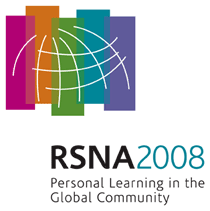
Abstract Archives of the RSNA, 2008
Bruce Ian Reiner MD, Abstract Co-Author: Nothing to Disclose
Sigurdur Sigurdsson, Abstract Co-Author: Nothing to Disclose
Tara Ann Morgan MD, Presenter: Nothing to Disclose
Khan Mohammad Siddiqui MD, Abstract Co-Author: Employee, Microsoft Corporation, Redmond, WA
Co-founder, iVirtuoso, Inc, Baltimore, MD
Medical Advisory Board, General Electric Company, Barrington, IL
Naomi J. Saenz, Abstract Co-Author: Nothing to Disclose
Rakhi Goel MD, Abstract Co-Author: Nothing to Disclose
Eliot Lawrence Siegel MD, Abstract Co-Author: Research grant, General Electric Company
Research grant, Siemens AG
Speakers Bureau, TeraRecon, Inc
Advisory Board, Mercury Computer Systems, Inc
Board of Directors, Carestream Health, Inc
Research grant, XYBIX Systems, Inc
Research grant, Steelcase, Inc
Research grant, Anthro Corp
Research grant, RedRick Technologies Inc
Research grant, Evolved Technologies Corporation
Research grant, Barco nv
Research grant, Intel Corporation
Research grant, Herman Miller, Inc
Research grant, Anatomical Travelogue, Inc
Occupational stress within the radiologist community is problematic and appears to be increasing as the demand and complexity of imaging services continues to grow. The objective of the study was to ascertain the extent of occupational stress within the radiologist community and determine what specific factors correlate most strongly with radiologist stress.
An on-line survey of the radiologist community was conducted with respondents given the Perceived Stress Scale (PSS), a 14-item measure of stress. Respondents were also provided with a questionnaire that assessed demographic, occupational, and technology data. A stepwise regression analysis was used to evaluate stress predictors.
A total of 192 radiologists participated in the study with a mean PSS score of 36.65. The measured PSS scores were found to strongly correlate with radiologist perceived occupational stress and job satisfaction (p < 0.01). The specific factors that were found to correlate with PSS scores included radiologist age (p < 0.01), computer comfort level (p < 0.01), number of weekly work hours (p = 0.01), and geographic location of practice (0 = 0.02). Highest PSS scores were associated with increasing age, low levels of computer comfort, high weekly work hours, and urban practice location. These 4 factors collectively accounted for 22% of the variability in perceived stress scores.
Causative factors contributing to occupational stress within the radiologist community are multi-factorial in nature and include radiologist age, practice location, number of work hours, and technology comfort level. Information about the major causes of stress should be made available to radiologists, particularly residents and fellows who may want to find a situation that maximizes job satisfaction and minimizes stress levels.
In order to minimize stress and improve job satisfaction, it is critical that the radiologist community understand the causative factors of stress and develop counteractive strategies.
Reiner, B,
Sigurdsson, S,
Morgan, T,
Siddiqui, K,
Saenz, N,
Goel, R,
Siegel, E,
Identifying Causative Factors of Occupational Stress within the Radiologist Community. Radiological Society of North America 2008 Scientific Assembly and Annual Meeting, February 18 - February 20, 2008 ,Chicago IL.
http://archive.rsna.org/2008/6019746.html

